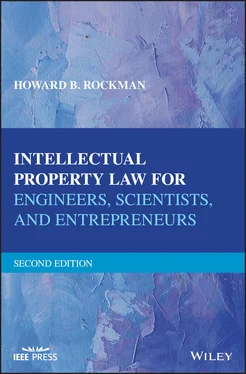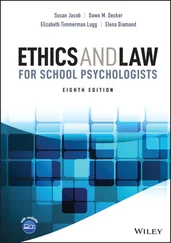7.4 ADDITIONAL MATTERS DISCUSSED DURING THE INVENTION DISCLOSURE MEETING BETWEEN THE INVENTOR AND THE PATENT PROFESSIONAL
7.4.1 Confidentiality of the Meeting
The meeting at which the inventor discloses the invention to the patent attorney is held in strict confidence, and the confidentiality of the invention is protected by the attorney/client privilege. This ensures that the client need not fear that the attorney will “steal” the invention. If the inventor is not satisfied with this explanation, the attorney can sign an NDA binding the attorney to secrecy regarding the invention. However, the cannons of ethics which bind an attorney to confidentiality regarding information passing between the client and the attorney are sufficient to re‐assure the inventor of the confidentiality of his/her invention disclosure. In view of the fact that an attorney may lose his or her license to practice law, and therefore the ability to earn a living, upon violating the cannons of ethics of the profession, it is extremely rare, and I have never known it to happen, that an attorney would attempt to misappropriate the invention of one of his/her clients.
7.4.2 Does the Invention Qualify for Patent Protection
Once the disclosure of the invention has been provided to the patent attorney, the attorney must decide and discuss with the inventor whether the subject matter is sufficiently concrete, and not merely conceptual, to qualify for patent protection. Next, it must be determined whether the invention falls within one of the statutory classes covered under Patent Law—that is, if the invention is a process, machine, manufacture, or a composition of matter, and/or any new and useful improvement thereof. The patent attorney must also determine whether an article patent, method patent, design patent, or a combination of several of these would best serve your purposes. Also, the possibility of using trade secret, trademark, and copyright protection must also be discussed, depending upon the nature of the invention.
7.4.3 Preliminary Novelty Inquiry
The inventor must disclose to the attorney at the patent disclosure meeting all material information known to the inventor which is relevant to related prior technology, either of the inventor or of others. For example, any information or activities the inventor has knowledge of regarding the use or disclosure of a similar device or process, or whether there are any third‐party publications, articles, or prior patents which disclose the invention of which the inventor is aware, should be discussed. These articles, patents, and other materials should also be produced to the patent attorney. All of such printed and electronic information in books, articles, brochures, and patent publications, as well as general knowledge and items that are available to the public, are all included within the definition of “prior art” against which the novelty of the invention is measured, and which the claims of the patent application must avoid covering.
Chapter 8discusses the pre‐examination patentability search that is sometimes conducted to discover prior art that may bear on the patentability of your invention. This search will ultimately disclose whether or not there is a single prior art publication or event that would destroy novelty under 35 U.S.C. §102(a) or (b), or whether the invention is rendered obvious through a combination of prior art materials under 35 U.S.C. §103.
7.4.4 Determining the Date of Invention
The inventor should also disclose to the patent attorney the events and the dates of those events relating to the conception, diligence, and reduction to practice of the invention. This includes the initial activities of the inventor in conceiving the invention, and the sketches and rough drawings, usually on scrap paper, cocktail napkins, or lab notebooks, as discussed previously. This information is important if it becomes necessary to initiate a derivation proceeding against a first‐to‐file applicant who misappropriated your invention.
7.4.5 Will the Invention Work as Claimed by the Inventor?
Sufficient information must be given to the patent attorney by the inventor to establish that the invention will work for its intended purposes. The Constitutional mandate states that patents can only be granted for advances in the “useful” arts. A patent cannot be granted for an inoperative device or method, such as a perpetual motion machine, and a patent is subject to post‐grant cancellation if the device is proven to be inoperative. Thus, the inventor should be prepared at the initial invention disclosure meeting to provide sufficient information establishing the workability of the invention. A model need not be presented to the patent attorney since the patent attorney has a technical background.
7.4.6 A Brief Comment Regarding Foreign Patent Rights
The inventor should ask the patent attorney to explain the ability to obtain foreign patent rights covering the invention, considering the possibility of any prior public disclosure by the inventor that may have adversely affected such foreign patent rights. The attorney should explain to the inventor whether or not there has been any affect on foreign patent rights due to the prior activities of the inventor before the initial invention disclosure meeting. The subject of foreign patent rights is covered in more detail in Chapter 16.
7.4.7 What the Prior Art Lacks
The inventor should disclose to the patent attorney those problems which exist in the art, and how the proposed invention is designed to solve such problems. Also, the inventor should describe what prior art devices or process he or she is aware of that have attempted to solve the same problems, and how the prior art devices have failed to solve such problems. The inventor should explain in full detail how his/her invention, which is being considered for patentability, particularly solves those problems in the prior art that no one else has been able to solve. This information is important for the preparation of a persuasive patent application.
7.4.8 Inventor’s Initial Concept of Novel Features
The inventor next describes his or her understanding of what is believed to be novel about the invention for which a patent is being sought. There may be one or more points of novelty. Remember, no patentability search has yet been conducted to determine what actually may be novel about the invention, so the only reference point at this meeting is the inventor’s knowledge.
Although the inventor will explain what he/she believes the novelty to be, it is always prudent to conduct a patentability search of prior art patents and literature to determine more precisely what the point of novelty is, and upon what features of the invention it can be expected that valid patent claims can be obtained. This patentability search, and indeed the examination process itself, may indicate to the inventor that his or her initial thoughts regarding novelty were not exactly correct, but that other novel features do reside in the invention for which patentability can be claimed. This process is known as “shifting the point of novelty,” and is quite common in the prosecution and development of patents.
To prepare a patent application that will support all points of novelty, all of the structure, operation, and advantages of the invention, as well as the results of the invention, should be clearly disclosed to the patent professional by the inventor. Thus, the patent application will be drafted with all necessary elements included, so that, if the point of novelty shifts during the examination process, the new novel elements relied upon will be included in the application. Thus, it is important to present a full disclosure of the invention to the patent professional. Once a patent application is filed, no new matter can be added to the application.
Читать дальше












